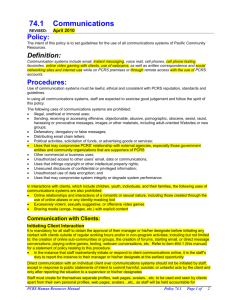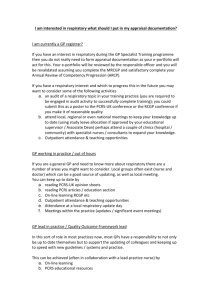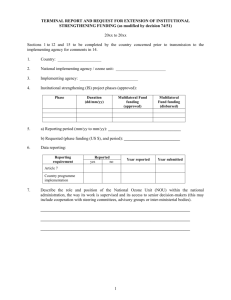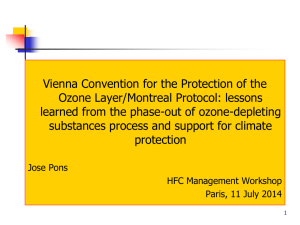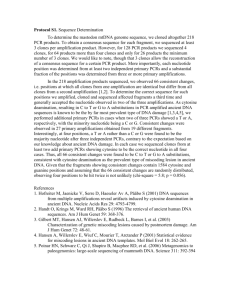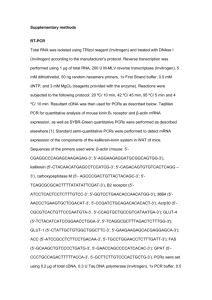2015 consolidated project completion report
advertisement
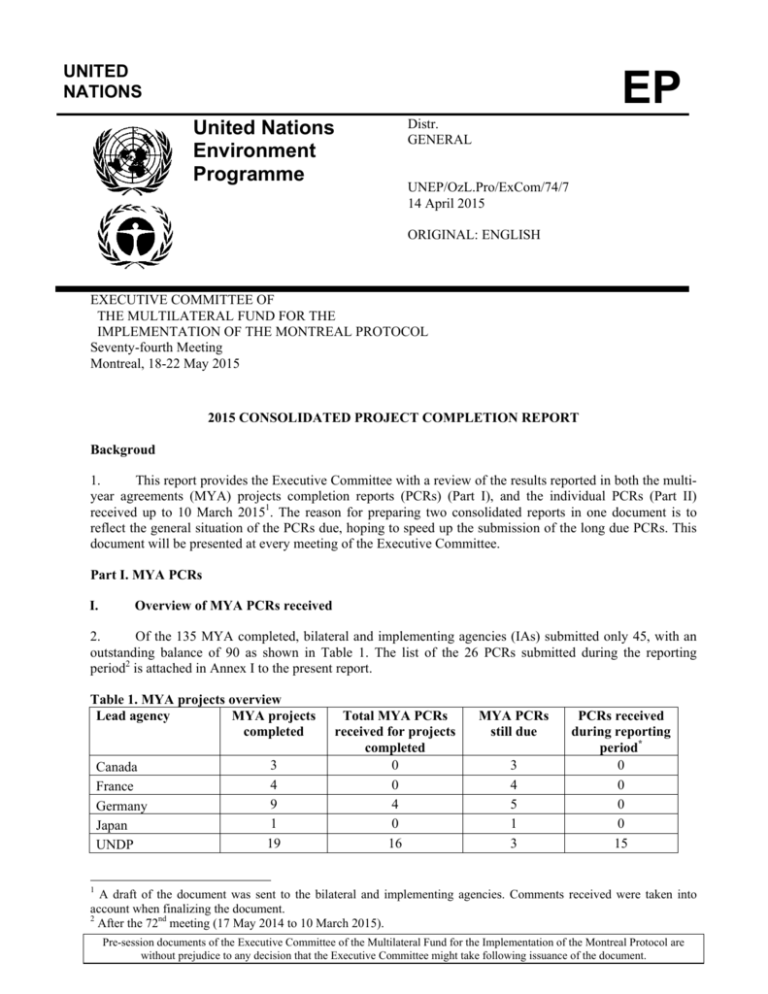
UNITED NATIONS EP United Nations Environment Programme Distr. GENERAL UNEP/OzL.Pro/ExCom/74/7 14 April 2015 ORIGINAL: ENGLISH EXECUTIVE COMMITTEE OF THE MULTILATERAL FUND FOR THE IMPLEMENTATION OF THE MONTREAL PROTOCOL Seventy-fourth Meeting Montreal, 18-22 May 2015 2015 CONSOLIDATED PROJECT COMPLETION REPORT Backgroud 1. This report provides the Executive Committee with a review of the results reported in both the multiyear agreements (MYA) projects completion reports (PCRs) (Part I), and the individual PCRs (Part II) received up to 10 March 20151. The reason for preparing two consolidated reports in one document is to reflect the general situation of the PCRs due, hoping to speed up the submission of the long due PCRs. This document will be presented at every meeting of the Executive Committee. Part I. MYA PCRs I. Overview of MYA PCRs received 2. Of the 135 MYA completed, bilateral and implementing agencies (IAs) submitted only 45, with an outstanding balance of 90 as shown in Table 1. The list of the 26 PCRs submitted during the reporting period2 is attached in Annex I to the present report. Table 1. MYA projects overview Lead agency MYA projects completed Canada France Germany Japan UNDP 3 4 9 1 19 Total MYA PCRs received for projects completed 0 0 4 0 16 MYA PCRs still due 3 4 5 1 3 PCRs received during reporting period* 0 0 0 0 15 1 A draft of the document was sent to the bilateral and implementing agencies. Comments received were taken into account when finalizing the document. 2 After the 72nd meeting (17 May 2014 to 10 March 2015). Pre-session documents of the Executive Committee of the Multilateral Fund for the Implementation of the Montreal Protocol are without prejudice to any decision that the Executive Committee might take following issuance of the document. UNEP/OzL.Pro/ExCom/74/7 Lead agency MYA projects completed UNEP UNIDO World Bank Grand Total 47 34 18 135 Total MYA PCRs received for projects completed 6 19 0 45 MYA PCRs still due PCRs received during reporting period* 1 10 0 26 41 15 18 90 *After the 72nd meeting (17 May 2014 to 10 March 2015). 3. The Secretariat reviewed the PCRs submitted with respect to budget and expenditure, phase-out achieved, implementation delays, overall assessment and lessons learned, as described below. II. Budget and expenditure 4. Table 2 shows that the total actual expenditures for the 26 MYA PCRs were reported to be 99.97 per cent of the planned expenditures indicating some overall savings. These data need to be reconfirmed once the final financial reports become available. Table 2. Budget approved and actual (US $) Lead agency Number of MYA funding per MYA PCRs agreement (US $) 15 1 10 26 UNDP UNEP UNIDO Total III. 71,395,082 325,000 37,901,344 109,621,426 MYA approved funds (US $) 71,325,712 324,600 37,442,016 109,092,328 MYA funds disbursed (US $) 71,325,712 324,600 37,408,606 109,058,918 ODS phase-out achieved 5. ODS phase-out in the projects covered by the 26 MYA PCRs is found to be as planned for most of the cases, as shown in Table 3. Table 3. ODS phase-out Lead agency Number of MYA PCRs UNDP UNEP UNIDO Total *As of 31 December 2013. IV. 15 1 10 26 ODP phase-out per agreement ODP phase-out approved (Inventory) 12,984.1 7.9 5,110.2 18,102.2 13,988.4 7.9 5,119.1 19,115.4 ODP phase-out actual (Progress report)* 13,988.4 7.9 5,219.9 19,216.2 Implementation delays 6. Out of the 26 MYA PCRs, 23 showed delays ranging from four months to 61 months; one was completed before the scheduled date; and two were completed on time, as shown in Table 4. In 61.5 per cent of PCRs there were delays of more than 12 months. 2 UNEP/OzL.Pro/ExCom/74/7 Table 4. Average duration and implementation delays of MYAs Lead agency Number of MYA PCRs Average duration (months) UNDP 15 87.26 UNEP 1 41.60 UNIDO 10 84.63 Total 26 84.49 V. Average delays (months) 18.97 12.20 25.59 21.25 Schedule for submission of PCRs in 2015 7. The IAs submitted schedules for submission of PCRs due for projects completed as of 31 December 2013 as shown in Table 5. Bilateral and IAs will also submit PCRs in 2015 for projects completed during 2014. Table 5. Schedule for submission of outstanding MYA PCRs in 2015 Lead Agency Schedule May 2015 June 2015 World Bank July 2015 September 2015 November 2015 Sector CFC Phase Out Plan (1) Production (1)* Production (4) ODS Phase Out Plan (1) Foam (1) ODS Phase Out Plan (1) ODS Phase Out Plan – MAC (1) ODS Phase Out Plan - Foam (1) ODS Phase Out Plan – Aerosol (1) Production (1) CFC Phase Out Plan (1) Production (3) CTC Sector Plan (1) Total UNDP June 2015 ODS Phase Out Plan (1) Solvent (1) Total UNEP May 2015 June 2015 UNIDO** October 2015 Total April 2015 May 2015 Jun 2015 July 2015 September 2015 October 2015 November 2015 December 2015 CFC Phase Out Plan (34) ODS Phase Out Plan (6) CFC Phase Out Plan (8) ODS Phase Out Plan (1) ODS Phase Out Plan (3) CFC Phase Out Plan Production ODS ODS Phase Out Plan Methyl Bromide ODS Phase Out Plan Solvent ODS Phase Out Plan ODS phase out plan 3 Completed MYAs MYAs by Decisions 6 1 2 3 1 4 1 18 2 2 2 32 8 9 41 1 1 1 1 1 1 1 3 11 1 UNEP/OzL.Pro/ExCom/74/7 Lead Agency Schedule December 2015 January 2016 February 2016 March 2016 April 2016 May 2016 Jun 2016 July 2016 September 2016 October 2016 November 2016 December 2016 Total Sector ODS phase out plan ODS phase out Refrigeration Servicing (CFC) CFC phase out plan CFC phase out plan ODS phase out plan Methyl Bromide CFC phase out plan CFC phase out plan Methyl Bromide CFC phase out plan CFC phase out plan Completed MYAs MYAs by Decisions 1 1 1 1 1 1 1 1 14 1 1 1 1 7 * Includes a PCR for the bilateral project from the United States of America, the CFCs, CTC and halon accelerated phase-out plan in China (CPR/PRO/44/INV/425 and CPR/PRO/47/INV/439). **Schedule for submission of Morocco’s Methyl Bromide sector still to be submitted. VI. Causes of delays 8. Enterprise related delays are mostly associated with the lack of alternative availability; slow conversion and production; administrative and procurement issues such as contract signing, payments and site preparation. Similarly, suppliers and contractors underwent delays in equipment delivery and manufacturing. 9. Government issues such as complex administrative procedures (i.e., lengthy customs clearance); difficulties in designating a national counterpart institution; other national priorities (i.e., Panama Canal expansion); and delays in the adoption of policies, were mentioned as causes for project deferral. VII. Lessons learned 10. All PCRs conveyed lessons from project implementation experience. Below are some highlights. Project design, preparation and implementation 11. Global strategies cannot necessarily be replicated in countries without recognizing its particular situation (i.e., Brazil’s mostly informal servicing sector). International relations and trade can provide impetus to move towards the success of the phase-out programme for ODS (i.e., Turkey’s engagement with the European Union in trade and other ODS related rules and prohibitions). 12. Early consultations with all stakeholders at project inception to identify good baseline situation and set clear and measurable objectives has been a fundamental part of successful implementation. Flexibility and creativity within the project implementation, allowing for adjustments when needed, is a key factor to a project’s success. Building on the synergies of existing projects and drawing on these experiences helped the IA to save valuable time and manage quick start-ups at the country level. 13. Limited funding of demonstration component restricted the number of participating companies. It limited information dissemination on alternative technologies and benefits of newer equipment models that achieve better energy efficiency gains. For example, in Mexico, the procedures developed to measure and verify electricity savings were essential to guarantee that chiller manufacturers offered the best products and 4 UNEP/OzL.Pro/ExCom/74/7 stood behind them, which in turn attracted the institutions and companies, concerned about savings in energy and maintenance. 14. Smaller and technologically limited stakeholders need closer technical assistance to achieve their goals (i.e., In Indonesia, new machines needed more electric capacity and larger investments, which the enterprises couldn’t afford). However, small companies are more open to change and to try alternatives. 15. Brazil’s demonstration projects used financial incentives to foster innovative practices which end-users were reluctant to engage in. Similarly, in Mexico new technologies, new systems and open participation of the technicians allowed the change of mind and culture. 16. Delivering equipment by commodatum contracts in Colombia, led to delays in project implementation. However, commodatum contracts are considered a good initiative. For example, the commodatum contract induced compulsory recovery and recycling of refrigerant gases and subsequently strengthened the technical practices of technicians. 17. Not all manufacturing industries had certified technicians to install HCFC refrigeration. In Brazil, there was a lack of proper equipment and tools to recover ODS in most of the companies providing maintenance services, therefore investment activities were essential. In Benin, projects have illustrated the need to purchase equipment within a single tranche, due to equipment transport cost and its significant impact on the budget of the tranche, which is especially true for lower-cost projects with more tranches. 18. Lessons from Lebanon’s methyl bromide (MB) use in agriculture showed that best results can be obtained when combining different MB alternatives. All MB alternatives need to be applied in the context of an integrated crop management program. Additionally, field demonstration sessions are an excellent way to communicate information to farmers and to convince them to adopt MB alternatives. Floating tray technology was considered a success in Malawi and was adopted by tobacco growers. The technology, however, is imported and thus investment-related. Technology import may impede local production of trays. It was observed in Malawi that a certain disease, which was prevalent in the 1960s, came back at the introduction of floating trays. The farmers’ knowledge on the issues was essential to ending it by applying the appropriate chemical. Availability of alternative technology 19. Procurement of new international equipment may be technically and financially difficult. In order to support companies, a study tour to visit the supplier’s factory combined with in-house technical training courses have proved useful. Procurement process of alternative technology must be better coordinated so proper sourcing is taken and short lists prepared to assure that qualified bidders participate. While research and development using universities, experts, importers and industries are key to select the proper alternative technology, discussions with suppliers to promote these technologies is fundamental to increase their availability. 20. Lebanon projects mentioned the need for MB alternatives to be tailored according to the different practices in a given region and needs to be tested prior to being adopted in the concerned country. Accordingly, the mode of application should be adjusted to the agricultural infrastructure of the country. Capacity building and training 21. National capacity building is a cost-effective method of project implementation. Flexible training and contingency planning efforts need to be permanent due, in part, to rotation of personnel within official and private organizations. Additionally, well-established and functioning relationship between IAs and national ozone units (NOUs) facilitates an efficient, proactive and successful project execution. 5 UNEP/OzL.Pro/ExCom/74/7 22. Communicating with and involvement of the industry’s associations, academy and enterprises helped design appropriate capacity building programmes, actions and policy instruments, which created a conducive environment and sense of ownership for the stakeholders in the implementation of phase-out projects. Such partnerships should be maintained during the implementation of the HCFC phase-out management plan. 23. Hands-on training and (electronic) networking among trainers and end-users, through workshops, dissemination of success stories, and periodic review meetings are decisive in improving technical skills and providing capacity building services to countries. 24. The regionalization of project in Colombia ensured wider coverage, which in turn strengthen the refrigeration and air-conditioning sector nationwide. Similarly, in Dominican Republic, the development of training courses in the provinces helped increase the technical knowledge of technicians as well as the demand for alternative refrigerants. Policy and regulation awareness 25. Legal regulations that played a major role in the CFC phase-out are crucial in controlling the phaseout of HCFCs. They must be discussed in advance with the involved sectors to facilitate the gradual accomplishment of established targets. For example, Argentina’s ban on CFC uses had impacted technology transformation tools. The timeframe for its application in the HCFC phase-out should consider the various types of stakeholders involved, innovators and early adopters as well as the laggards, so the ban can be considered a stimuli and not an impossible barrier to overcome. 26. Intra-governmental dialog and coordination secure effective agreements with the various sectors of the national economy. Local authorities’ knowledge of the regional sector as well as stakeholders networking is essential to build and maintain cooperation with the governmental counterparts to ensure programme ownership and support. 27. In Turkey, awareness raising and training activities were systematically carried out as a first step in the promotion of demonstration projects. They were continued throughout the investment projects’ lifetime and played a major role in the commercial adoption of the alternatives. Intensive awareness-raising activities were also necessary to ensure sufficient diffusion of legal measures supporting MB phase-out. Part II. Individual PCRs I. Overview of PCRs received and due 28. This part of the document provides an overview of the PCRs received during the reporting period of 11 September 2014 to 10 March 2015. 29. Seven PCRs were received for investment projects (Table 6) and six PCRs for non-investment projects (Table 7). The list of the 13 individual PCRs submitted during the reporting period is attached in Annex II to the present report. Table 6: PCRs submitted for investment projects (except multi-year projects) Agency France Germany Italy Japan Spain Completed projects up PCRs received to December 2013 15 122 19 193 10 104 6 6 1 1 6 PCRs still due 3 0 0 0 0 PCRs Received during the reporting period1 1 N/A N/A N/A N/A UNEP/OzL.Pro/ExCom/74/7 Agency United Kingdom of Great Britain and Northern Ireland United States of America UNDP UNIDO World Bank Total Completed projects up PCRs received to December 2013 1 1 2 893 444 455 1,846 2 8935 4446 4527 1,840 PCRs still due 0 PCRs Received during the reporting period1 N/A 0 0 0 3 6 N/A 2 2 2 7 1 11 September 2014 to 10 March 2015. In addition, France submitted 1 PCR for multi-year project. 3 In addition Germany submitted 1 PCR for multi-year project. 4 In addition, Italy submitted 1 PCR for multi-year project. 5 In addition, UNDP submitted 2 PCRs for cancelled projects and 3 PCRs for multi-year projects. 6 In addition, UNIDO submitted 2 PCRs for cancelled projects, 9 cancellation reports, 22 PCRs for multi-year projects and 2 PCRs for ongoing projects. 7 In addition, the World Bank submitted 2 PCRs for cancelled projects. 2 Table 7: PCRs submitted for non-investment projects* Agency Australia Austria Canada Czech Republic Denmark Finland France Germany Israel Japan Poland Portugal South Africa Spain Sweden Switzerland United States of America UNDP UNEP UNIDO World Bank Total Completed projects up to December 2013 25 1 57 2 1 5 31 54 2 13 1 1 1 3 5 3 40 262 428 112 39 1,086 PCRs received PCRs still due 252 1 55 2 1 5 14 51 2 8 1 0 1 3 53 3 40 2614 4105 1126 36 1,036 0 0 2 0 0 0 17 3 0 5 0 1 0 0 0 0 0 1 18 0 3 50 PCRs Received during the reporting period1 N/A N/A 0 N/A N/A N/A 0 0 N/A 0 N/A 0 N/A N/A N/A N/A N/A 1 0 1 4 6 * Except project preparations, country programmes, multi-year projects, and on-going projects like networking and clearing-house activities as well as institutional strengthening projects). 1 11 September 2014 to 10 March, 2015. 2 In addition, Australia submitted 1 PCR for cancelled project. 3 In addition, Sweden submitted 3 PCRs for multi-year projects and 3 PCRs on transferred projects. 4 In addition, UNDP submitted 2 PCRs on transferred projects, 1 PCR for multi-year project and 1 PCR for project completed in 2014. 5 In addition, UNEP submitted 12 PCRs for multi-year projects. 6 In addition, UNIDO submitted 3 PCRs for multi-year projects. 30. The Secretariat reviewed the PCRs submitted with respect to budget and expenditure, phase-out achieved, implementation delays, overall assessment and lessons learned, as described below.3 3 This review does not include country programmes, project preparation, or UNEP’s recurrent activities (including networking), which do not require PCRs as per decision 29/4. 7 UNEP/OzL.Pro/ExCom/74/7 II. Budgets, phase-out, duration and delays reported in PCRs 31. Total expenditures were 95.3 per cent of the planned expenditures indicating some overall savings, as shown in Table 8. This data needs to be reconfirmed once the final financial figures become available. Table 8: Budgets, phase-out and delays reported in PCRs Agency Number of projects Approved funds (US $) Funds disbursed (US $) ODP to be ODP phased phased out out (ODP (ODP tonnes) tonnes) Average duration (months) Average delays (months) France 1 1,006,652 637,046 61.0 61.0 105.50 55.80 UNDP 3 9,720,854 9,720,481 185.4 185.4 79.14 39.23 UNIDO World Bank 3 4,097,694 4,097,694 190.8 190.8 51.07 17.90 6 2,544,096 2,104,100 651.8 933.2 96.21 67.13 Total 13 17,369,296 16,559,321 1,089.0 1,370.4 82.57 48.46 32. The delays experienced in project implementation varied widely. All of the 13 projects experienced delays in implementation ranging from 12 months to 140 months, with an average delay of 48.46 months. 33. The difference in ODP phase-out planned and reported as achieved is almost entirely due to one project implemented by the World Bank for which the actual ODS phase-out was reported to be more than planned. 34. Bilateral and IAs rated 23.1 per cent of projects as highly satisfactory and 53.8 per cent as satisfactory as planned as shown in Table 9. The validity of such assessments can only be verified during evaluations. Table 9: Overall assessment of non-investment projects by the IAs Assessment France World UNDP UNIDO Bank Highly satisfactory 3 Satisfactory or satisfactory as planned 1 4 2 Satisfactory though not as planned 1 Less satisfactory 1 Not applicable 1 Total 1 6 3 3 III. Total 3 7 1 1 1 13 Percentage of total 23.1 53.8 7.7 7.7 7.7 100.0 Schedule for submission of PCRs in 2015 35. The IAs have submitted schedules for submission of PCRs for projects completed as of 31 December 2013 due in 2015 at the 73rd meeting, except for UNEP as shown in Table 10. Table 10. Schedule for submission of outstanding PCRs in 2015 Agency Schedule Sector Aerosol (1) CFC Phase-out Plan (1) UNEP May 2015 Halon (1) Refrigeration (4) Several (5) 8 Non-investment PCRs 12 UNEP/OzL.Pro/ExCom/74/7 Agency IV. Schedule September 2015 Total Sector Refrigeration Non-investment PCRs 6 18 4 Improve consistency of data reported in PCRs and in annual progress reports 36. Decision 73/5(b)(i) requested bilateral and IAs, in cooperation with the Secretariat, to establish full consistency of data reported in the PCRs, in the Inventory of approved projects database and the annual progress reports by end of December 2014. The Secretariat provided all agencies with detailed information on data completeness and inconsistencies of PCRs received in comparison to the Inventory and the progress reports. All cases of incomplete information and data inconsistencies in PCRs received in 2003, 2004, 2005, 2009, 2010 and 2011 have now been resolved, while this process still continues for World Bank projects in 2006, 2007, 2008, 2012 and 2013. V. Causes of delays Technical assistance projects 37. In Argentina, delays were caused by issues related to money transfer between the IA and the operators and change of staff at the government level. The World Bank hired a consultant and solved the first problem while meetings and discussions solved the second one. Demonstration projects 38. Lengthy research for the technical infrastructure, and the lack of experience of in situ personnel delayed trials and impeded production standards. In addition, administrative obstructions caused further delays of project implementation. For example, a change of the blowing agent needs the acceptance of the local environmental bureau which may take years to get. Therefore, follow-up and cooperation among agencies, companies and the government is crucial for the successful project implementation. 39. Climatic conditions during harvest season as well as health issues (i.e., a dengue epidemic that occurred in the work zones in Argentina) forced the postponement of projects to the next year's harvest season. 40. In Cuba, the lack of spare parts required for the operation of chillers was a cause of delay. Investment projects 41. Suppliers-related delays include lack of suitable offers of equipment; late delivery; complications related to the creation of a new pharmaceutical formulation; and local implementation of foreign complex technology. Close support from technology suppliers and special provisions in the contracts helped to contravene these issues. 42. At the enterprise level, limited financial assistance necessitated counterpart funding. However, some enterprises mentioned the need to set up their investment budget early without obtaining funding confirmation, which may impacted project implementation in the demonstration phase. 4 In order to improve consistency of data and facilitate the preparation of PCRs, since July 2004 bilateral and IAs can download key project data from the website of the Secretariat. When indicating the project number or title, the first page of the PCR forms will be automatically filled in with data from the Secretariat's project Inventory database, including actual data and remarks from the last progress reports. 9 UNEP/OzL.Pro/ExCom/74/7 43. Government-related delays concerned the selection of the national institution responsible for training; the appointment of a qualified consultant; and various financial agreement signatures. VI. Lessons learned Aerosol 44. The government should play an active role in completing contractual arrangements with the enterprises in a timely manner. Performance-based payment modality is efficient and helps to fast-track project implementation. 45. It is necessary to be precise in the elaboration of each term in the commercial contracts to avoid delays and when possible, to contract the technological transfer with recognized and experienced companies. UNDP mentioned the need to take a more active role in the day-to-day management of the project in order to coordinate with international partners. As demonstrated in other MDI projects, several factors can delay implementation, such as legal issues, development of new formulation, approval of these formulations by the national regulatory body, and production start-up. Foam 46. Carrying out research in advance helps the beneficiary enterprise find a better formula before the trials and avoid delays in project implementation. Communication between local authorities and the company must start at project inception. To accelerate market penetration of polyurethane (PU) foam containing HFC245fa, a market outreach plan should be included in the project design in order to educate end-users on the need to phase out HCFC-141b and the quality of the new HFC-245fa blown PU foam. Fumigant 47. More flexible implementation timeframes and lesser restrictions on the alternative methods are needed for testing new technologies in the treatment of seasonal products. In Argentina, the demonstration showed that in the end, only cold treatment was viable for citrus, and for economic reasons only in larger companies. Halon 48. The assistance provided by an international expert to establish a halon bank helped better define the components of the project and build consensus in sectors lacking experience in halon management, including the capacity to identify the most appropriate laboratory equipment and the most expedient mechanism to achieve results. 49. Counterpart funding can affect project implementation as well as enterprise decision to participate in the project. Some halon users were unable to cover the additional expenditures required and had to withdraw from the project. In Thailand, despite the delay in appointing a consultant to assist the national agency in preparing action plans for non-essential halon users and despite a lower number of participating enterprises in conversion and demonstration phases, overall project achievements were satisfactory. RECOMMENDATION 50. The Executive Committee may wish to consider: (a) Taking note of the 2015 consolidated project completion reports (PCR) contained in document UNEP/OzL.Pro/ExCom/74/7; 10 UNEP/OzL.Pro/ExCom/74/7 (b) Urging implementing agencies to submit to the 75th meeting the backlog of PCRs for multiyear agreements (MYA) and individual projects as contained in Tables 5 and 10, respectively of the present report, and in the event that PCRs due were not submitted, to provide the reasons for not submitting them and the schedule for submission; and (c) Inviting all those involved in the preparation and implementation of MYA and individual projects to take into consideration the lessons learned from PCRs when preparing and implementing future projects. ---- 11 UNEP/OzL.Pro/ExCom/74/7 Annex I Annex I MYA PROJECT COMPLETION REPORTS RECEIVED Country Agreement Title Lead Agency Algeria Antigua and Barbuda Argentina Benin Brazil China Colombia Costa Rica Cuba ODS phase out plan CFC Phase Out Plan Methyl bromide CFC phase out plan CFC phase out plan Tobacco ODS phase out plan CFC phase out plan ODS phase out plan UNIDO World Bank UNDP UNEP UNDP UNIDO UNDP UNDP UNDP Democratic People's Republic of Korea Dominican Republic Georgia Indonesia Domestic Refrigeration UNIDO CFC phase out plan CFC phase out plan ODS phase out plan Refrigeration Manufacturing ODS phase out plan Refrigeration Servicing CFC phase out plan Refrigeration Manufacturing Methyl bromide Cut Flowers CFC phase out plan Methyl bromide Strawberries Methyl bromide CFC phase out plan CFC phase out plan CTC phase out plan Refrigerant management plan CFC phase out plan Methyl bromide CFC phase out plan CFC phase out plan UNDP UNDP UNDP Indonesia Iran (Islamic Republic of) Kenya Lebanon Lebanon Malawi Mexico Nigeria Pakistan Pakistan Panama Turkey Uruguay Venezuela (Bolivarian Republic of) 1 Cooperating Agency UNIDO Germany Germany, France, Canada UNDP UNDP UNIDO UNDP UNIDO UNDP UNIDO UNDP UNIDO UNIDO UNDP UNIDO UNDP UNIDO UNDP World Bank UNIDO UNEP Canada UNEP/OzL.Pro/ExCom/74/7 Annex II Annex II INDIVIDUAL PROJECT COMPLETION REPORTS RECEIVED Code ARG/FUM/29/DEM/93 ARG/HAL/26/TAS/80 BGD/ARS/52/INV/26 CPR/FOA/59/DEM/492 Agency World Bank World Bank UNDP CPR/REF/61/DEM/502 World Bank World Bank UNIDO CUB/ARS/41/INV/23 UNDP CUB/REF/47/DEM/36 UNDP EGY/FUM/56/INV/98 UNIDO KEN/FUM/65/INV/52 UNIDO MOR/FUM/29/INV/37 PHI/FUM/44/TAS/76 France World Bank World Bank CPR/FOA/59/INV/493 THA/HAL/32/INV/134 Project title Demonstration project for testing methyl bromide alternatives in post-harvest disinfestation for cotton and citrus (phase I) National halon management programme to help eliminate the use of halon1301 in new applications and to manage recovered halon-1301 Phase-out of CFC consumption in the manufacture of aerosol MDIs (Beximco, Square Pharmaceutical and Acme Pharmaceutical) Conversion of the foam part of Jiangsu Huaiyin Huihuang Solar Co. LTD. from HCFC-141b to cyclopentane Conversion from HCFC-141b-based to HFC-245fa-based spray polyurethane foam at Harbin Tianshuo Building Materials Co. Ltd. Demonstration sub-project for conversion of room air-conditioning compressor manufacturing from HCFC-22 to propane at Guangdong Meizhi Co. Phase-out of CFC consumption in the manufacture of aerosol metered dose inhalers (MDIs) Demonstration project for integrated management of the centrifugal chiller sub-sector, focusing on application of energy-efficient CFC-free technologies for replacement of CFC-based chillers National phase-out of methyl bromide in horticulture and commodities fumigation except in date use Technical assistance for the final elimination of methyl bromide (MeBr) in post-harvest sector in Kenya. Phase-out of methyl bromide use in the cut flower and banana production Technical assistance for a national methyl bromide phase-out strategy Terminal halon-1211 and halon-1301 phase-out project for fire equipment manufacturers and suppliers converting to ABC powder, CO2, HFC-227ea and inert gases 1
